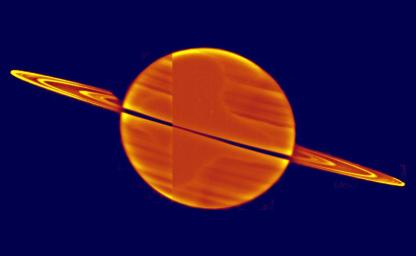
|
Sunset on Saturn’s Rings
- Click the image above for a larger view
- Full-Res JPEG (944 x 582) (28.4 kB)
- Full-Res TIFF (944 x 582) (446.8 kB)
Caption:
This is a rare view of Saturn's rings seen just after the Sun has set below the ring plane, taken with the Hubble Space Telescope on Nov. 21, 1995.
This perspective is unusual because the Earth is slightly above (2.7 degrees latitude) Saturn's rings and the Sun is below them. Normally we see the rings fully illuminated by the Sun.
The photograph shows three bright ring features: the F Ring, the Cassini Division, and the C Ring (moving from the outer rings to the inner). The low concentration of material in these rings allows light from the Sun to shine through them. The A and B rings are much denser, which limits the amount of light that penetrates through them. Instead, they are faintly visible because they reflect light from Saturn's disk.
Scientists believe that the F Ring is slightly warped because it disappears part way around on the right (West) side. Hubble's high resolution shows the that A Ring's shadow obscures part of the F ring (right).
The image was assembled from 20 exposures taken with Wide Field Planetary Camera-2 over 8 hours.
Background Info:
The Wide Field/Planetary Camera 2 was developed by the Jet Propulsion Laboratory and managed by the Goddard Space Flight Center for NASA's Office of Space Science.
This image and other images and data received from the Hubble Space Telescope are posted on the World Wide Web on the Space Telescope Science Institute home page at URL http://oposite.stsci.edu/ .
Cataloging Keywords:
| Name | Value | Additional Values |
|---|---|---|
| Target | Saturn | A Ring, B Ring, Cassini Division, F Ring, Saturn Rings |
| System | Saturn | |
| Target Type | Planet | Gap, Ring |
| Mission | Hubble Space Telescope (HST) | |
| Instrument Host | Hubble Space Telescope | |
| Host Type | Space Telescope | |
| Instrument | Wide Field/Planetary Camera 2 (WFPC2) | |
| Detector | ||
| Extra Keywords | Color, Disk, Infrared, Shadow, Visual | |
| Acquisition Date | ||
| Release Date | 1998-08-02 | |
| Date in Caption | 1995-11-21 | |
| Image Credit | NASA/JPL/STScI | |
| Source | photojournal.jpl.nasa.gov/catalog/PIA01270 | |
| Identifier | PIA01270 | |
